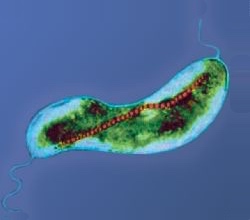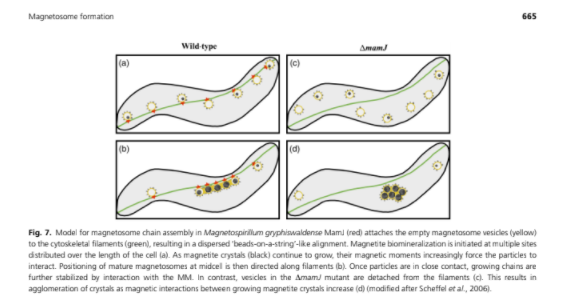|
Magnetotaxis
Magnetotaxis is a process implemented by a diverse group of Gram-negative bacteria that involves orienting and coordinating movement in response to Earth's magnetic field. This process is mainly carried out by microaerophilic and anaerobic bacteria found in aquatic environments such as salt marshes, seawater, and freshwater lakes. By sensing the magnetic field, the bacteria are able to orient themselves towards environments with more favorable oxygen concentrations. This orientation towards more favorable oxygen concentrations allows the bacteria to reach these environments faster as opposed to random movement through Brownian motion. Overview Magnetic bacteria (e.g. '' Magnetospirillum magnetotacticum'') contain internal structures known as magnetosomes which are responsible for the process of magnetotaxis. After orienting to the magnetic field using the magnetosomes, the bacteria use flagella to swim along the magnetic field, towards the more favorable environment. Magnetotaxi ... [...More Info...] [...Related Items...] OR: [Wikipedia] [Google] [Baidu] |
Magnetotactic Bacteria
Magnetotactic bacteria (or MTB) are a polyphyletic group of bacteria that orient themselves along the magnetic field lines of Earth's magnetic field. Discovered in 1963 by Salvatore Bellini and rediscovered in 1975 by Richard Blakemore, this alignment is believed to aid these organisms in reaching regions of optimal oxygen concentration. To perform this task, these bacteria have organelles called magnetosomes that contain magnetic crystals. The biological phenomenon of microorganisms tending to move in response to the environment's magnetic characteristics is known as magnetotaxis. However, this term is misleading in that every other application of the term taxis involves a stimulus-response mechanism. In contrast to the magnetoreception of animals, the bacteria contain fixed magnets that force the bacteria into alignment—even dead cells are dragged into alignment, just like a compass needle. Introduction The first description of magnetotactic bacteria was in 1963 by Sa ... [...More Info...] [...Related Items...] OR: [Wikipedia] [Google] [Baidu] |
Marine Bacteria
Marine prokaryotes are marine bacteria and marine archaea. They are defined by their habitat as prokaryotes that live in marine environments, that is, in the saltwater of seas or oceans or the brackish water of coastal estuaries. All cellular life forms can be divided into prokaryotes and eukaryotes. Eukaryotes are organisms whose cells have a nucleus enclosed within membranes, whereas prokaryotes are the organisms that do not have a nucleus enclosed within a membrane. The three-domain system of classifying life adds another division: the prokaryotes are divided into two domains of life, the microscopic bacteria and the microscopic archaea, while everything else, the eukaryotes, become the third domain. Prokaryotes play important roles in ecosystems as decomposers recycling nutrients. Some prokaryotes are pathogenic, causing disease and even death in plants and animals. [...More Info...] [...Related Items...] OR: [Wikipedia] [Google] [Baidu] |
Magnetospirillum Magnetotacticum
''Magnetospirillum'' is a Gram-negative, microaerophilic genus of magnetotactic bacterium, first isolated from pond water by the microbiologist R. P. Blakemore in 1975. They have a spiral (helical) shape and are propelled by a polar flagellum at each end of their cells. Four species have been described: ''M. magnetotacticum'' strain MS-1 (originally classified as ''Aquaspirillum magnetotacticum''; ''M. magneticum'' strain AMB-1; ''M. gryphiswaldense'' and ''M. bellicus''. Habitat The typical habitat of ''Magnetospirillum'' species consists of shallow fresh water and sediments, characterized by low concentrations of oxygen for growth (microaerophilic) where they live in the upper portion of the sediment (oxic/anoxic interface) and prefer an oxygen gradient of around 1–3%. Magnetotaxis Probably the most peculiar characteristic of ''Magnetospirillum'' species is their capacity to orient themselves according to Earth's magnetic field, magnetotaxis. This is achieved through the ... [...More Info...] [...Related Items...] OR: [Wikipedia] [Google] [Baidu] |
Magnetosome
Magnetosomes are membranous structures present in magnetotactic bacteria (MTB). They contain iron-rich magnetic particles that are enclosed within a lipid bilayer membrane. Each magnetosome can often contain 15 to 20 magnetite crystals that form a chain which acts like a compass needle to orient magnetotactic bacteria in geomagnetic fields, thereby simplifying their search for their preferred microaerophilic environments. Recent research has shown that magnetosomes are invaginations of the inner membrane and not freestanding vesicles. Magnetite-bearing magnetosomes have also been found in eukaryotic magnetotactic algae, with each cell containing several thousand crystals. Overall, magnetosome crystals have high chemical purity, narrow size ranges, species-specific crystal morphologies and exhibit specific arrangements within the cell. These features indicate that the formation of magnetosomes is under precise biological control and is mediated biomineralization. Magnetotactic b ... [...More Info...] [...Related Items...] OR: [Wikipedia] [Google] [Baidu] |
Aerotaxis
Aerotaxis is the movement caused by oxygen gradients. Positive aerotaxis involves the movement toward higher concentration of environmental oxygen, while negative aerotaxis involves the movement towards a lower concentration of environmental oxygen . Aerotactic bacteria gather around sources of air forming aerotactic bands. Discovery The discovery of aerotaxis was first reported by Theodore Wilhelm Engelmann, as he showed microaerophilic ''Spirillum tenue'' were attracted by low oxygen concentrations. Ten decades after the first discovery of this movement, it was observed that bacteria are actually bound to areas with optimal oxygen concentrations; resulting in the formation of bands. It was concluded that the creations of these bands was largely in part to Oxygen's important role in metabolic pathways as they allowed for surveying aerotaxis in many bacterial species. This ability proves to be important for survival as efficient metabolism directly relates to growth. Aerotaxis not ... [...More Info...] [...Related Items...] OR: [Wikipedia] [Google] [Baidu] |
Magnetosome
Magnetosomes are membranous structures present in magnetotactic bacteria (MTB). They contain iron-rich magnetic particles that are enclosed within a lipid bilayer membrane. Each magnetosome can often contain 15 to 20 magnetite crystals that form a chain which acts like a compass needle to orient magnetotactic bacteria in geomagnetic fields, thereby simplifying their search for their preferred microaerophilic environments. Recent research has shown that magnetosomes are invaginations of the inner membrane and not freestanding vesicles. Magnetite-bearing magnetosomes have also been found in eukaryotic magnetotactic algae, with each cell containing several thousand crystals. Overall, magnetosome crystals have high chemical purity, narrow size ranges, species-specific crystal morphologies and exhibit specific arrangements within the cell. These features indicate that the formation of magnetosomes is under precise biological control and is mediated biomineralization. Magnetotactic b ... [...More Info...] [...Related Items...] OR: [Wikipedia] [Google] [Baidu] |
Greigite
Greigite is an iron sulfide mineral with the chemical formula . It is the sulfur equivalent of the iron oxide magnetite (Fe3O4). It was first described in 1964 for an occurrence in San Bernardino County, California, and named after the mineralogist and physical chemist Joseph W. Greig (1895–1977). Natural occurrence and composition It occurs in lacustrine sediments with clays, silts and arkosic sand often in varved sulfide rich clays. It is also found in hydrothermal veins. Greigite is formed by magnetotactic bacteria and sulfate-reducing bacteria. Greigite has also been identified in the sclerites of scaly-foot gastropods. The mineral typically appears as microscopic (< 0.03 mm) isometric hexoctahedral crystals and as minute sooty masses. Association minerals include , |
Magnetoception
Magnetoreception is a sense which allows an organism to detect the Earth's magnetic field. Animals with this sense include some arthropods, molluscs, and vertebrates (fish, amphibians, reptiles, birds, and mammals, though not humans). The sense is mainly used for orientation and navigation, but it may help some animals to form regional maps. Experiments on migratory birds provide evidence that they make use of a cryptochrome protein in the eye, relying on the quantum radical pair mechanism to perceive magnetic fields. This effect is extremely sensitive to weak magnetic fields, and readily disturbed by radio-frequency interference, unlike a conventional iron compass. Birds have iron-containing materials in their upper beaks. There is some evidence that this provides a magnetic sense, mediated by the trigeminal nerve, but the mechanism is unknown. Cartilaginous fish including sharks and stingrays can detect small variations in electric potential with their electroreceptive ... [...More Info...] [...Related Items...] OR: [Wikipedia] [Google] [Baidu] |
Magnetic Dipole
In electromagnetism, a magnetic dipole is the limit of either a closed loop of electric current or a pair of poles as the size of the source is reduced to zero while keeping the magnetic moment constant. It is a magnetic analogue of the electric dipole, but the analogy is not perfect. In particular, a true magnetic monopole, the magnetic analogue of an electric charge, has never been observed in nature. However, magnetic monopole quasiparticles have been observed as emergent properties of certain condensed matter systems. Moreover, one form of magnetic dipole moment is associated with a fundamental quantum property—the spin of elementary particles. Because magnetic monopoles do not exist, the magnetic field at a large distance from any static magnetic source looks like the field of a dipole with the same dipole moment. For higher-order sources (e.g. quadrupoles) with no dipole moment, their field decays towards zero with distance faster than a dipole field does. External m ... [...More Info...] [...Related Items...] OR: [Wikipedia] [Google] [Baidu] |
Pyrite
The mineral pyrite (), or iron pyrite, also known as fool's gold, is an iron sulfide with the chemical formula Fe S2 (iron (II) disulfide). Pyrite is the most abundant sulfide mineral. Pyrite's metallic luster and pale brass-yellow hue give it a superficial resemblance to gold, hence the well-known nickname of ''fool's gold''. The color has also led to the nicknames ''brass'', ''brazzle'', and ''Brazil'', primarily used to refer to pyrite found in coal. The name ''pyrite'' is derived from the Greek (), 'stone or mineral which strikes fire', in turn from (), 'fire'. In ancient Roman times, this name was applied to several types of stone that would create sparks when struck against steel; Pliny the Elder described one of them as being brassy, almost certainly a reference to what we now call pyrite. By Georgius Agricola's time, , the term had become a generic term for all of the sulfide minerals. Pyrite is usually found associated with other sulfides or oxides in quartz v ... [...More Info...] [...Related Items...] OR: [Wikipedia] [Google] [Baidu] |
Gram-negative Bacteria
Gram-negative bacteria are bacteria that do not retain the crystal violet stain used in the Gram staining method of bacterial differentiation. They are characterized by their cell envelopes, which are composed of a thin peptidoglycan cell wall sandwiched between an inner cytoplasmic cell membrane and a bacterial outer membrane. Gram-negative bacteria are found in virtually all environments on Earth that support life. The gram-negative bacteria include the model organism ''Escherichia coli'', as well as many pathogenic bacteria, such as ''Pseudomonas aeruginosa'', '' Chlamydia trachomatis'', and ''Yersinia pestis''. They are a significant medical challenge as their outer membrane protects them from many antibiotics (including penicillin), detergents that would normally damage the inner cell membrane, and lysozyme, an antimicrobial enzyme produced by animals that forms part of the innate immune system. Additionally, the outer leaflet of this membrane comprises a complex lipopol ... [...More Info...] [...Related Items...] OR: [Wikipedia] [Google] [Baidu] |
Magnetite
Magnetite is a mineral and one of the main iron ores, with the chemical formula Fe2+Fe3+2O4. It is one of the oxides of iron, and is ferrimagnetic; it is attracted to a magnet and can be magnetized to become a permanent magnet itself. With the exception of extremely rare native iron deposits, it is the most magnetic of all the naturally occurring minerals on Earth. Naturally magnetized pieces of magnetite, called lodestone, will attract small pieces of iron, which is how ancient peoples first discovered the property of magnetism. Magnetite is black or brownish-black with a metallic luster, has a Mohs hardness of 5–6 and leaves a black streak. Small grains of magnetite are very common in igneous and metamorphic rocks. The chemical IUPAC name is iron(II,III) oxide and the common chemical name is ''ferrous-ferric oxide''. Properties In addition to igneous rocks, magnetite also occurs in sedimentary rocks, including banded iron formations and in lake and marine sediment ... [...More Info...] [...Related Items...] OR: [Wikipedia] [Google] [Baidu] |






